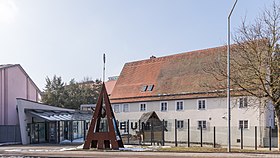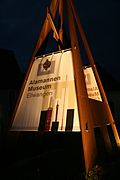Alamannenmuseum Ellwangen
 Exterior view of the museum (2018) |
|
| Data | |
|---|---|
| place |
Ellwangen |
| Art |
Archaeological Museum
|
| opening | 2001 |
| operator |
City of Ellwangen
|
| management | |
| Website | |
| ISIL | DE-MUS-742016 |
The Alemanni Museum in Ellwangen was opened in 2001 and, with finds from all over southern Germany, gives a lively overview of 500 years of Alemanni history from the early Middle Ages . Due to the difficult budget situation in the city of Ellwangen, the city council discussed a closure of the museum in 2010. The Alemanni Museum is open from Tuesday to Friday between 2 p.m. and 5 p.m. and on Saturday and Sunday between 1 p.m. and 5 p.m.
building
The museum is located in the building of the so-called Nikolauspflege in Haller Straße, which was built in 1593, one of the oldest surviving poor and infirmary houses in southwest Germany .
This Nikolauspflege is a listed complex and consists of the Nikolauskapelle, which has a late medieval core and was rebuilt and redesigned in the 17th century, and the former beneficiary's house , which essentially dates from the end of the 16th century, was comprehensively renovated in the 18th century and was expanded south in the 1970s.
This entire complex is protected according to §§ 2 and 28 (12) of the Baden-Württemberg Monument Protection Act .
collection
Core of the collection
The core of the collection consists of finds that have been excavated near Lauchheim since 1986 . The largest Alemannic burial ground in Baden-Württemberg to date was uncovered - the Lauchheim burial ground - as well as the settlement to which it belonged, together with a manor with its own burial place. The many archaeological finds have not yet been fully evaluated, important publications and documentation are still missing, but the following basic statements can be made:
“The early medieval burial ground in the Gewann“ Wasserfurche ”was established between 1986 and 1996 by the Stuttgart Archaeological Monument Preservation under the direction of Dr. Ingo Stork completely excavated. Over 1300 documented grave finds, which can be assigned to the period between the second half of the 5th and the second half of the 7th century and which occupy a rectangular area of around 1.5 hectares, make this burial ground the largest documented cemetery of this period to date in southwest Germany. The complete excavation ensures a representative cross-section of an early medieval local society through the ages. "
"Mittelhofen settlement: 200 meters down the valley from the" Wasserfurche "cemetery, traces of settlement from the 6th to the 11th century were archaeologically examined in the" Mittelhofen "district between 1989 and 2006. Of great importance for science is on the one hand the good preservation of the building traces and on the other hand the size of the excavated areas. It is the most comprehensively documented early medieval settlement area in Baden-Württemberg to date. "
Well-preserved art, jewelry and everyday objects as well as weapons that are of outstanding importance for research are exhibited. A partially reconstructed pit house with a loom illustrates the textile processing of the Alemanni, another thematic focus is the history of the Christianization of the Alemanni . The modern presentation of the exhibits with reconstructions and electronic media gives an insight into the life of the Alemanni .
photos
Special exhibitions
Since the establishment of the Alemanni Museum, its director has endeavored to deepen knowledge about the early Middle Ages in the region, but above all knowledge about the Alemanni and the important burial grounds in the region. In many cases, there were also special showcases that represented a topic on a smaller scale:
- The Reiterkrieger von Pfahlheim (September 28, 2001 - January 11, 2004)
- The 'Lady of Kirchheim / Ries ' - robes and jewelry of the Alamannic woman (July 16, 2004 - January 9, 2005)
- From Wotan to Christ - The Alemanni and the Cross (March 9 - September 10, 2006)
- Three special showcases "Alemannic jewelry and weapon belts" (January 15 - May 22, 2007)
- Three special showcases “Appreciated - revered - feared. Damascus Swords of the Early Middle Ages "(August 2, 2007 - January 6, 2008)
- The Ostrogoths - Patrons of the Alamanni: New Research on the Ostrogoth Military in Carinthia (November 28, 2008 - April 19, 2009)
- Treasures from Hessigheim's soil - The burial ground in the "Muckenloch" (May 10 - October 25, 2009)
- The Alemanni on the Ostalb - early settlers in the area between Lauchheim and Niederstotzingen (June 25, 2010 - October 23, 2011)
- Museum-ready - 25 years of Alemannic excavations in Lauchheim (September 9, 2012 - January 13, 2013)
- Two brothers, one monastery: Ellwangen Abbey between piety and politics. In search of the Alemannic-Franconian roots of the founding of the monastery in 764 (July 26, 2014 - January 18, 2015)
- Special showcase "The 'Trinity Primer" from Freiberg -Beihingen, Grave 81 "with listening station" The death of the dear little ones "(since June 1, 2017)
- Gold leaf crosses - signs of faith of the Alemanni (September 16, 2017 - April 8, 2018)
- Adored, used, forgotten. Alamanni in the field of tension between politics and contemporary history (October 27, 2018 - April 28, 2019)
- Well-heeled - textile production at the Alemanni , 7 February to 11 October 2020.
literature
- Andreas Gut : Alamannenmuseum Ellwangen , Kunstverlag Josef Fink, Lindenberg 2005, ISBN 3-89870-271-5 .
- Andreas Gut, Martina Terp-Schunter, Barbara Theune-Großkopf: Gold leaf crosses. Signs of faith of the Alemanni (= writings of the Alemanni Museum Ellwangen. Volume 3). Alamannenmuseum Ellwangen, Ellwangen 2017, ISBN 978-3-00-058380-3 .
- Susanne Arnold, Immo Eberl, Andreas Gut and Barbara Scholkmann: Two brothers, one monastery - The Ellwangen Abbey between piety and politics: In search of the Alemannic-Franconian roots of the foundation of the monastery in 764. Ed. By the Friends of the Alamannenmuseum Ellwangen (= writings of the Alamannenmuseum Ellwangen. Volume 2). Ellwangen 2014
- Ingo Stork: Prince and Farmer - Heath and Christ. 10 years of archaeological research in Lauchheim / Ostalbkreis. Published by the Alamannenmuseum Ellwangen Association (= writings of the Alamannenmuseum Ellwangen. Volume 1) - 1st edition 1995, 2nd, expanded edition 2001
Web links
- City of Ellwangen: Alamannenmuseum Ellwangen
Individual evidence
- ↑ Schwäbische Zeitung : Ellwangen in financial difficulties: Alamannenmuseum is threatened with closure , May 18, 2010.
- ^ City of Ellwangen: Alamannenmuseum Ellwangen - Alamannenmuseum Aktuell
- ^ State Office for the Preservation of Monuments in Baden-Württemberg: Ellwangen and his monuments. Gift and obligation (= conservation plan, edited by Volkmar Eidloth and Marie Schneider, published by the Geschichts- und Altertumsverein Ellwangen eV and the city of Ellwangen (Jagst)) - Ellwangen (Jagst), 2014. pp. 192 and 145/146.
- ^ Website of the Archaeological Monument Preservation , accessed on March 11, 2018.
- ↑ Publication by the State Monuments Office Esslingen on the DFG project , accessed on March 11, 2018.
- ↑ Andreas Gut (Ed.): The Alamannen on the Ostalb: Early settlers in the area between Lauchheim and Niederstotzingen , Archäologische Informations aus Baden-Württemberg, H. 60, Stuttgart 2010, ISBN 978-3-942227-00-1 .
- ↑ Susanne Arnold, Immo Eberl, Andreas Gut and Barbara Scholkmann: Two brothers, one monastery - The Ellwangen Abbey between piety and politics: In search of the Alemannic-Franconian roots of the foundation of the monastery in 764. Ed. By the Alamannenmuseum Ellwangen association (= writings of the Alamannenmuseum Ellwangen. Volume 2). Ellwangen 2014
- ↑ Andreas Gut, Martina Terp-Schunter, Barbara Theune-Großkopf: Goldblattkreuze. Signs of faith of the Alemanni (= writings of the Alemanni Museum Ellwangen. Volume 3). Alamannenmuseum Ellwangen, Ellwangen 2017, ISBN 978-3-00-058380-3 .








